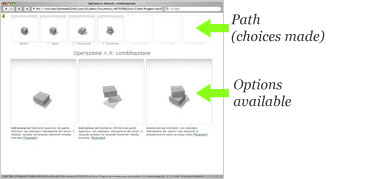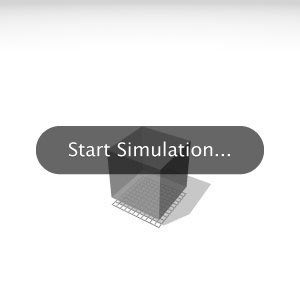Hypertext and Method. A research on design method that uses hypertext as a tool
Simulazione Progettuale
Before beginning the simulation, I suggest you to read to the paragraphs "Basic knowledge" and "Design Simulation Interface", in order to fully understand the meaning of the simulation and to get the finest design simulation experience :-)
Basic knowledge
You'll start from a cube, meant as space unit, in order to succeed in building your own conceptual image of space.
In order to catch up this objective, you will be able to carry out 6 operations on the cube: cut, translation, rotation, boolean, torsion and inflation.
For every operation 3 options will be available, each of which will be the result of the choices previously made.
The combination of the 3 options and the 6 operations very results in 729 possible solutions, all contained, in power, into the cube you start from.
Having only 3 options for each operation represents, metaphorically, the limitations to which the creativity of the designer is subordinate, when he faces a real project (laws, budget, requests from the client, and so on).
Being a micro-plan, the simulation must be completed in a time micro-arc. The time factor is very important because in 2-3 minutes you will be able to experience only some of the 729 solutions, therefore will have to make choices, true core of designing.
Design Simulation Interface
In the upper part of the screen you'll see the state of advance of the simulation.
This is made up of 7 boxes. The first one contains the Base Module (starting point of the simulation), the others 6 visualize the path of choices made and those still missing.
 Every link inside the State of Advance corresponds to a decisional node. You will always be able to select one of the nodes already decided to start simulation again from that point on.
Every link inside the State of Advance corresponds to a decisional node. You will always be able to select one of the nodes already decided to start simulation again from that point on.
This re-thinking will cause the cancellation of all the choices deriving from that node. The available time is short, the possible solutions many. Make your choices with responsibility!
Further Research Details
Applying a method to the designing process involves the adoption of a coherent set of rules rigidly structured. At the same time, a hypertext is a document connected to one or more documents with logical sense connections: the links. The totality of connections makes the structure of the hypertext.
Design Simulation was born yhanks to this analogy between design method and hypertext: both necessarily are based on a structure.
Starting from these bases, the project Hypertext and Method developed a ideal-type, that is a model that does not offer solutions to a specific design problem, but that can explain the mechanism to the base of the search of any progettuale solution.
The founding elements of this model are:
- choice
- reciprocity
- responsibility
- additivity
- systematic nature
A designer must face objectives and ties, when developing a design theme. The interpretation of the project datas carry him make decisions. Others choices will derive from ther first one, all bound by a condition of reciprocity. In fact, if on one side it is the choice to determine the existence of the next options, on the other side it is in that option itself that the choice finds the reason of its being-a-choice.
This process can be represented effectively from a series of subsequent bifurcations. Keeping one means to choose a direction and, consequentially, not-to choose all other possible options.
Consequently, the planner will have to choose with responsibility, because of the amount of not-choiced options that a choice involves.
Every choice represents a stone on which to continue to construct. The succession of all decisions makes the design process flow, that follows the additivity principle, of the stratification of the operations carried out on the elements of a composition.
The application of a method means, moreover, a systematic nature, that is coherence in the application of an organic set of rules and principles to the design process.
